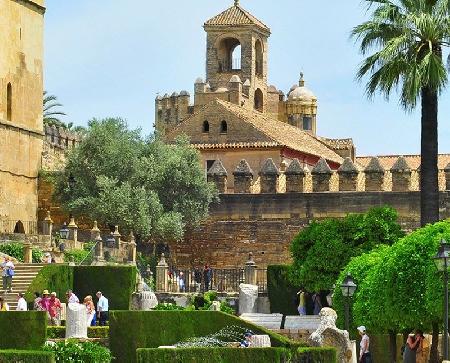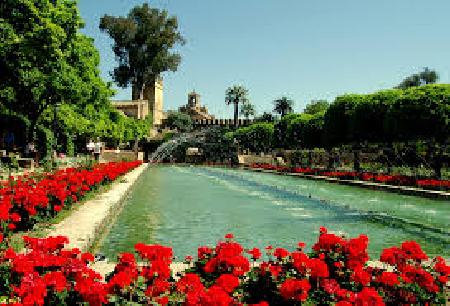 The Alcázar de los Reyes Cristianos or Alcázar de Córdoba is located in the city of Córdoba. The word "alcazar" itself means "palace" in Arabic, and there are several such residences of the Spanish monarchs in the country, the most luxurious of which is considered to be located in Seville. The Alcázar de Córdoba is, rightly, the second after Seville for its rich history, its beautiful gardens and its magnificent Mudejar architecture, which combines the characteristics of a comfortable residence with a powerful citadel.
The Alcázar de los Reyes Cristianos or Alcázar de Córdoba is located in the city of Córdoba. The word "alcazar" itself means "palace" in Arabic, and there are several such residences of the Spanish monarchs in the country, the most luxurious of which is considered to be located in Seville. The Alcázar de Córdoba is, rightly, the second after Seville for its rich history, its beautiful gardens and its magnificent Mudejar architecture, which combines the characteristics of a comfortable residence with a powerful citadel.
Historical reference
The first settlements existed in the place of Córdoba long before our era and belonged to the Celtiberian tribes. During the Numante War, the Roman general and consul Marco Claudio Marcelo had stayed in the winter apartments of Fort Córdoba in 152 B.C. Strabo writes about this fortress as a site inhabited by "select people from among the Romans and natives", this would be the first city founded by Rome on the Iberian Peninsula.
After the fall of the Roman Empire in 570-572, the Visigoths, after several attempts to conquer Córdoba, along with other cities, managed to establish their kingdom, which in 711 was conquered by the Arabs under the leadership of Mugit and became dependent on the caliphate of Damascus, the Emirate of Al-Andalus, which later gave the name to the Spanish region of Andalusia. In 756, the last of the Umayyad dynasty caliphs of Damascus, Abd al-Rahman ibn Muawiyah, took refuge in Cordoba and founded an independent state, the Caliphate of Cordoba.
In 1236, after long external wars and internal struggles, Córdoba lost its former greatness and significance by assaulting the troops of Castilla y León under the command of Fernando III el Santo. The Alcázar, in its almost current form, was established in 1328 by King Alfonso XI of Castilla y León. For the construction he used only a part of the ancient Arab palace that was of an incredible size, while the rest was distributed to churches, nobles and knights of the Order of Calatrava.
The fortress received its new name - "Alcázar de los Reyes Cristianos" - at the end of the 15th century, during the reign of Isabel de Castilla and Fernando de Aragón. Four monarchs lived here about ten years before the capture of Granada in 1492. They comfortably expanded and furnished the palace, which later became the site of many historical events. Thus, in the Alcázar, on June 19, 1482, Elizabeth gave birth to a daughter, Infanta María, the future Queen of Portugal and wife of King Manuel el Feliz. Christopher Columbus, who presented his plan for a naval expedition to India, was also received here in 1492. In 1493 the last Caliph of Granada Boabdil was a prisoner of the palace. With the permission of Isabel and Fernando, the court of the Holy Inquisition began its work in the Alcázar, and the Alcázar remained at its headquarters from 1490 to 1810.
In 1810, the French barracks were located here. After the Alcázar, it was occupied by a prison that existed from 1822 to 1931. In 1931 the palace was recognized as a historical monument and the first attempts at reconstruction were made. Then, until 1955, the military institutions stayed here, until finally the Alcázar was handed over to the Municipality of Córdoba. At the same time, the Alcázar was partially open to the public and visitors as an important sight in Córdoba.
In 1994, the Alcázar de los Reyes Cristianos was inscribed on the UNESCO List of Cultural Heritage of Humanity. In the second half of the 20th century, the palace was repeatedly restored and today it has partially returned to its old elegant style.
 Tourist information
Tourist information
The palace itself is an almost correct square. Created under the influence of Arab architecture, it has at the same time the characteristics of European Gothic, as well as styles from later times. According to the plan of its creators, the Alcazar was to become a symbol of Christianity's victory over Islam. The Tower of Respect is the main tower of the palace. Here is a reception hall, and at the top of the octagonal tower, vows were made in earlier times to protect Córdoba from the enemy to the last drop of blood, and from here the royal decrees were read. Created under the explicit influence of the French style of the time, the Tower of Respect is distinguished by its fine floating Gothic vaults and the carved vegetable ornaments that decorate the rooms.
Next to it is the Tower of the Inquisition or Tower of the Gardens, the highest in the palace, whose open balcony served as a place for public executions by hanging. Various archives and valuable royal documents have been kept within this tower for centuries. In the northwest part of the Alcázar, there is the Torre del León, named after one of the gargoyles that adorn its upper platform. It is the
